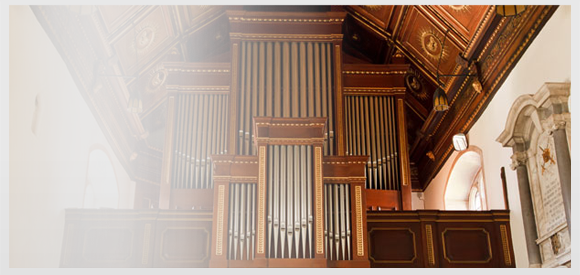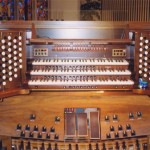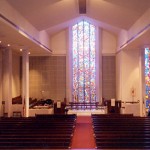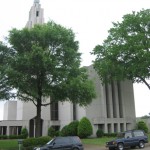First-Centenary United Methodist Church
The Methodists of Chattanooga were first organized in 1839 and met in a community log cabin at Ross’s Landing. In 1844 the Methodist churches of the South withdrew from the rest of Methodism over the issue of slavery and, until re-unification in 1939, became known as the Methodist Episcopal Church, South. A new building was procured in 1847 and used until the Union Army took it over during their occupation of Chattanooga from 1862 to 1870.
During the occupation, a chaplain of the Ohio Methodist Episcopal Conference was sent here at the request of locals who had been a member of the northern church. In 1868 the group became First Methodist Church and met in their first building, a plain wooden structure on Pine Street. In 1885 they built a beautiful stone church at Georgia and McCallie and a two-manual Hook & Hastings, Op. 1311, was installed. This organ served, with various renovations, for the duration of the building The stone for the building was quarried from a farm which is the present location of the Chattanooga Golf & Country Club. The structure was demolished in the early 1970s after the merger with Centenary Methodist Church. The lot was purchased by prominent members of the congregation who elected to preserve the tall steeple and make it part of a landscaped and concealed parking structure.
During the Civil War occupation, the members of the southern Methodist Church were in need of a facility, too. A small red brick building was built at the corner of 8th and Market, site of the former Loveman’s/Proffits department store. In 1884 the site was sold to D. B. Loveman and they built a beautiful stone structure at Eighth and Lindsay. A 2-manual 8-rank Pilcher was installed. The congregation quickly outgrew this building and purchased two lots at McCallie and Lindsay in 1908. A new structure wasn’t completed until 1922, when a 3-manual Pilcher was installed. It was replaced in 1966 by the Schantz.
CENTENARY METHODIST CHURCH
Henry Pilcher’s Sons, 1926, 3/22 (from THE DIAPASON January 1926)
GREAT
8′ Open Diapason
8′ Grossflote
8′ Viol d’Gamba
8′ Dulciana
4′ Flute d’Amour
8′ Tuba
SWELL
16′ Bourdon
8′ English Diapason
8′ Gedeckt
8′ Aeoline
8′ Salicional
8′ Voix Celeste
4′ Flute Harmonic
8′ Cornopean
8′ Oboe
Tremolo
CHOIR
8′ Violin Diapason
8′ Concert Flute
8′ Dolce
4′ Flauto Traverso
8′ French Horn
Tremolo
PEDAL
16′ Open Diapason
16′ Bourdon
16′ Lieblich Gedeckt SW
8′ Violoncello 12
8′ Flute Dolce SW
Centenary and First Methodist Churches merged in 1967. In 1968 the Methodist church united with the Evangelical United Brethren church – and the newly-merged local congregation then became the First-Centenary United Methodist Church.
In 1971 the congregation voted to build a new sanctuary – and the first service was held in the new facility on April 8, 1973. The Schantz was moved to the new sanctuary and is located with the choir to the left side of the chancel.
The new 800-seat sanctuary is a typical Harold Wagoner design, with the signature marble chancel floor, spectacular windows and the choir off to one side. The beautiful stained glass windows are by the reknowned Willet Studios. The huge chancel window was reputed to be the largest window in the world employing gold leaf. “A background of jeweled untextured, leaded glass is covered with a sculptured lead surface which is “flown” with 23-karat gold leaf. By day, the Story of Redemption (the window’s theme) is told in stained glass, cataracis of color in cliffs of masonry – and by night is told by the repousse.” The sanctuary has excellent acoustics and the organ sounds out well.
The 1966 console, mounted on an elevator, was replaced by a new one by Schantz in 1999. Seventeen pipe ranks and three digital 32′ stops by Musicom were added by Schantz to the original forty-two ranks in 2003. The
rededication service was held March 2, 2003
Schantz Organ Co., Opus 770, 3/59, 1966/2003
| GREAT | SWELL | CHOIR | ||||||
| 16′ | Gemshorn | 8′ | Diapason | 16′ | Erzahler | |||
| 8′ | Principal | 8′ | Rohrflote | 8′ | Principal | |||
| 8′ | Bordun | 8′ | Viole de Gambe | 8′ | Holzgedeckt | |||
| 8′ | Gemshorn | 12 | 8′ | Viole Celeste | 8′ | Viola Pomposa | ||
| 8′ | Harmonic Flute | 4′ | Geigen Principal | 8′ | Viola Celeste | |||
| 4′ | Octave | 4′ | Koppelflote | 8′ | Erzahler | |||
| 4′ | Quintade | 2 2/3′ | Nasat | 8′ | Erzahler Celeste | |||
| 2 2/3′ | Nazard | 2′ | Waldflote | 4′ | Fugara | |||
| 2′ | Super Octave | 1 3/5′ | Tierce | 4′ | Hohlflote | |||
| 1 3/5′ | Tierce | IV | Plein Jeu | 2′ | Prinzipal | |||
| IV | Mixture | 16′ | Basson | 1 1/3′ | Quinte | |||
| 16′ | Dulzian | prep | 8′ | Trompette | IV | Scharf | ||
| 8′ | Trumpet | 8′ | Hautbois | 8′ | Krummhorn | |||
| 8′ | Dulzian | prep | 8′ | Voix Humaine | 8′ | English Horn | ||
| Tremulant | 4′ | Chalumeau | Tremulant | |||||
| Sub | Tremulant | Sub | ||||||
| Unison Off | Sub | Unison Off | ||||||
| Chimes | Unison off | Super | ||||||
| Zimbelstern | Super | 8′ | Festival Trumpet | |||||
| 8′ | Festival Trumpet | CH | 8′ | Festival Trumpet | CH | MIDI | ||
| MIDI | MIDI | |||||||
| PEDAL | ||||||||
| 32′ | Contre Bourdon | dg | ||||||
| 16′ | Principal | |||||||
| 16′ | Bordun | |||||||
| 16′ | Gemshorn | GT | ||||||
| 16′ | Erzahler | CH | ||||||
| 10 2/3′ | Quinte | — | ||||||
| 8′ | Octav | |||||||
| 8′ | Bordun | 12 | ||||||
| 8′ | Gemshorn | GT | ||||||
| 8′ | Erzahler | CH | ||||||
| 4′ | Choralbass | |||||||
| 4′ | Nachthorn | |||||||
| 2′ | Nachthorn | 12 | ||||||
| IV | Mixture | |||||||
| 32′ | Contre Bombarde | dg | ||||||
| 32′ | Contre Basson | dg | ||||||
| 16′ | Posaune | |||||||
| 16′ | Basson | SW | ||||||
| 16′ | Dulzian | GT | ||||||
| 8′ | Posaune | 12 | ||||||
| 8′ | Basson | SW | ||||||
| 4′ | Klarine | 12 | ||||||
| 4′ | Hautbois | SW | ||||||
| 8′ | Festival Trumpet | CH | ||||||
| MIDI | ||||||||







